Past the
asteroid belt lies the gas giant planets:
Jupiter,
Saturn,
Uranus and
Neptune. Because of
their proximity to the
Sun during the
Solar System
formation, these planets were able to hold on to
their gas envelopes.Of all the planets, Jupiter
is the largest. The most prominent feature on the
planet is the swirling clouds and giant red spot.
Jupiter - A Quick Summary: (More information can be found on the Jupiter Fact Sheet and the Jovian Rings Fact Sheet)
|
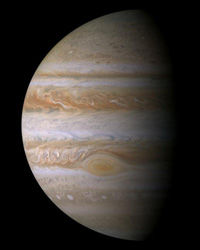 |
Average Distance from Sun: |
7.783 x 108 km |
| Eccentricity of Orbit: |
0.048 |
| Average Orbital Speed: |
13.1 km/s |
| Orbital Period: |
11.86 years |
| Rotational Period
(equatorial): |
9h 50m 28s |
| Inclination of Equator to
Orbit |
1.30º |
| Diameter (equatorial): |
142,984 km |
| Mass: |
1.899 x 1027 kg |
|
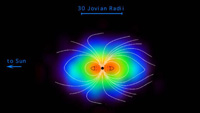 |
Average Density: |
1,326 kg/m3 |
| Escape Speed: |
60.2 km/s |
| Albedo: |
0.44 |
|
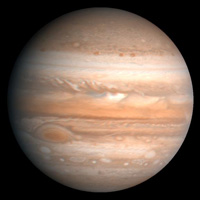 |
| Average Cloud-Top
Temperature: |
-108º
C |
| Atmospheric
Composition: |
86.2% hydrogen |
| 13.6% helium |
| 0.2% methane |
| ammonia |
| water vapor |
Back to Top Atmosphere: The most
remarkable and most visible feature of Jupiter is it
atmosphere. We see belts of clouds in intricate
patterns. The cloud patterns consist of:
- Polar regions
- Temperate regions
- Tropical regions
- Equatorial regions
Each region consists of:
- Belts - darker bands - falling gas - low
pressure
- Zones - lighter bands - rising gas -
high pressure
The belts and zone provide the swirling
affects. The rotation of Jupiter is the
engine that drives all of the motion as well
as internal heat. Because of internal
heating, the wind speeds can reach up to 500
km/h.
Since its not a solid body like
Earth, rotation
is
differential like our
Sun - the
center rotates faster than the poles. The
image below demonstrates the atmospheric structure
of the Gas Giants including Jupiter:
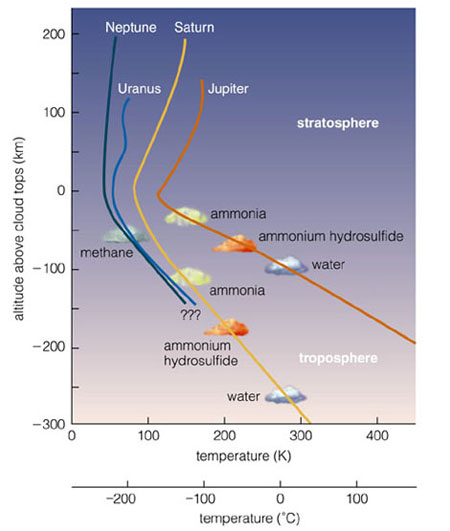
The image above provides much information like gross
composition,
temperature and altitude.
The Giant Red Spot (GRS) is actually a super storm
similar to hurricanes on
Earth. Since there are no
oceans to control
temperature and no land or
mountains to alter the wind streams, the GRS is
capable of sustaining its energy.
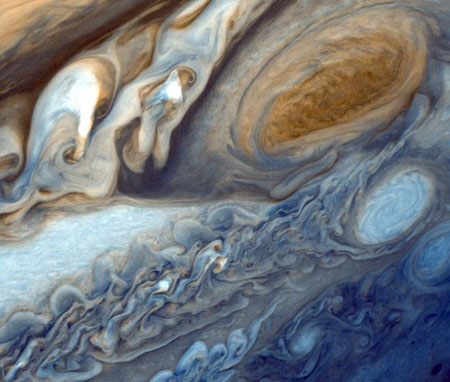
This enhanced Voyager image shows the GRS up close,
the patterns of the clouds indicate the storm is
rotating counter-clockwise.
Back to Top
The Interior:
We know very little about the interior of Jupiter
but can infer a small core and liquid or gas as the
remaining contents because of the lower
density of
Jupiter compared to
Earth. The intense magnetic
field allows Astronomers to create a model of the
interior:
- 1000 km thick atmosphere
- Liquid hydrogen "crust" - very thick
- Liquid metallic hydrogen "mantle"
- Rocky core
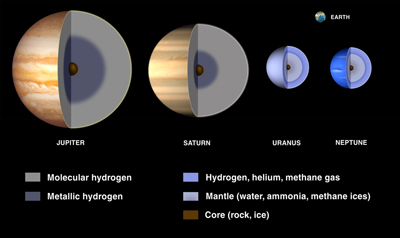
The liquid metallic hydrogen interior
provides the solution for Jupiter's
intense magnetic field.
Back to Top
The Rings:
Saturn is best know for its rings, but it is not the
only gas giant to have them. In fact all of the gas
giant planets have rings, Jupiter included. The
rings are viewable from
Earth with only the largest
telescopes.
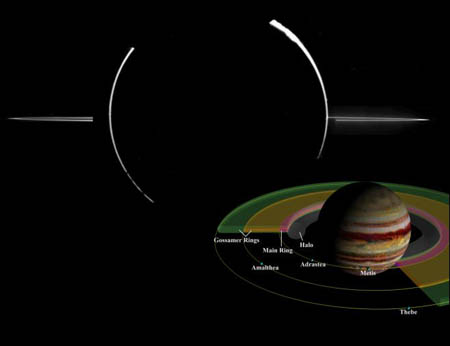
Just like
Saturn, Jupiter also has shepherd moons to
help maintain the ring structure. While the material
of the ring is dusty and icy particles like
Saturn,
it is though that Io also supplies some of the
debris.
Back to Top |

